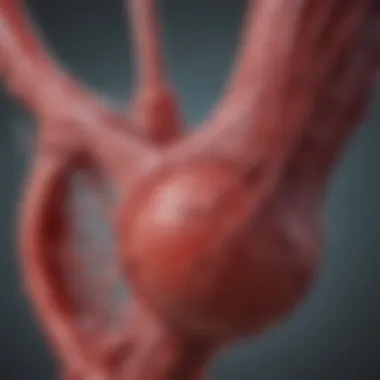Understanding the Causes and Implications of Blood Clots


Intro
Blood clots, while essential for wound healing, can lead to severe health complications if not understood properly. This article examines the intricate web of factors contributing to blood clot formation and the subsequent health implications. Identifying these factors is pivotal for enhancing public understanding and promoting effective preventive measures.
The exploration begins with a review of the multifactorial nature of blood clots, highlighting various risk factors and underlying medical conditions that contribute to their formation. Understanding these elements will provide insights into how blood clots develop and their potential consequences on human health.
Moreover, this piece emphasizes the importance of lifestyle choices, such as diet, exercise, and smoking, in influencing clot formation. By analyzing current research and expert opinions, it aims to offer an in-depth perspective that is both informative and actionable for healthcare professionals and the general public.
The significance of recognizing the risks associated with blood clots cannot be overstated. They can affect different organ systems, leading to various complications, some of which may be life-threatening. Therefore, this comprehensive overview serves as a vital resource for understanding the relevance of blood clots in today’s health discourse.
The Nature of Blood Clots
Understanding the nature of blood clots is crucial for grasping the broader implications they have on health. Blood clots are not simply a nuisance; they can signal significant medical issues or, in some cases, life-threatening conditions. Their formation and subsequent effects can alter the state of the body dramatically.
Definition and Formation
Blood clots form when the body’s hemostasis process is triggered. Hemostasis is the mechanism that prevents and stops bleeding, ensuring that blood remains fluid within the vessels while allowing for the repair of any vascular injuries. In simple terms, a clot is a semi-solid mass of blood, primarily made of platelets and fibrin.
When an injury occurs, the body responds through a cascade of biological events. First, blood vessels constrict to reduce bleeding. Then platelets adhere to the site of injury, forming a temporary plug. This is followed by the coagulation cascade, where various proteins work to create a stable clot. The inappropriate formation of clots can lead to conditions like deep vein thrombosis or pulmonary embolism.
Normal Blood Coagulation Process
The normal blood coagulation process is a highly regulated sequence involving several steps:
- Vascular spasm: Blood vessels constrict following injury.
- Platelet plug formation: Platelets adhere to the exposed collagen in blood vessels and aggregate to form a plug.
- Coagulation cascade activation: A series of clotting factors are activated. Eventually, this leads to the conversion of fibrinogen into fibrin, which stabilizes the clot.
- Clot retraction and repair: The clot contracts to reduce its size, allowing healing to begin.
While this process is vital for maintaining hemostasis, dysregulation can lead to pathological clotting. This misbalance may result from various factors, including genetic predispositions, medical conditions, and lifestyle choices. The implications of these clotting events can be severe, making understanding their formation an essential aspect of medical research and patient care.
Types of Blood Clots
Understanding the types of blood clots is essential for recognizing their impact on human health. Blood clots can form in different locations and under various circumstances, leading to a spectrum of complications. Knowing the distinctions between arterial, venous, and microthrombi helps healthcare providers in diagnosis and treatment strategies. Each type has unique characteristics, implications for health, and management options.
Arterial Clots
Arterial clots are thromboses that occur in arteries, the blood vessels that supply oxygen-rich blood from the heart to various organs. These clots generally form in response to damage to the arterial wall, often due to factors such as atherosclerosis, where fatty deposits build up in the artery. Arterial clots can lead to serious events, including heart attacks and strokes, as they block blood flow to critical areas.
The symptoms of arterial clots vary depending on their location. For instance, a clot in a coronary artery can provoke chest pain, while a clot in the brain can result in neurological deficits. Timely identification is crucial, as treatments may include anticoagulants, thrombolytics, and surgical interventions.
Venous Clots
Venous clots usually develop in the deep veins, particularly in the legs, a condition known as deep vein thrombosis (DVT). These clots can occur when blood flow decreases, often due to extended periods of immobility, such as during long flights or bed rest during surgery. Unlike arterial clots, venous clots do not usually cause immediate harm by obstructing blood flow to vital organs. However, they present a risk of dislodgement, leading to potentially fatal pulmonary embolism.
Symptoms of venous clots may include swelling, pain, and discoloration in the affected limb. The management of venous clots often involves anticoagulant therapy and, in some cases, the use of compression stockings.
Microthrombi
Microthrombi are small clots that can form in the smallest blood vessels and capillaries. They are often associated with inflammatory conditions or infections. Microthrombi can lead to complications like organ dysfunction if they impair blood flow. While they may not produce substantial symptoms on their own, they contribute to persistent health issues like chronic fatigue or long COVID symptoms.
Microthrombi emphasize the need for a broader perspective on clot-related health issues, including their subtle and chronic implications.
Recognizing the various types of blood clots is crucial for both medical professionals and individuals. The differences in their formation, symptoms, treatment, and complications underscore the complexity of clotting disorders and their wide-ranging effects on health.
Causes of Blood Clots
Understanding the causes of blood clots is crucial for comprehending their implications on health. Blood clots can lead to serious conditions such as stroke, heart attack, and pulmonary embolism. Preventing blood clots requires identifying and managing risk factors effectively. Various genetic traits, medical issues, lifestyle habits, and hormonal influences contribute to the formation of clots. Awareness of these causes enables timely interventions and informed medical decisions.


Genetic Factors
Genetic factors play a significant role in predisposing individuals to blood clots. Certain inherited conditions can significantly increase the likelihood of clotting disorders.
Inherited Thrombophilia
Inherited thrombophilia is a condition where individuals have an increased tendency to form blood clots due to genetic mutations. This aspect is crucial for understanding blood clot risks. The key characteristic of inherited thrombophilia is its hereditary nature, which makes it a vital subject in this article. A unique feature of this condition is that individuals often remain asymptomatic until a clot event occurs. The advantage of identifying this condition early can lead to proactive monitoring and prevention strategies.
Gene Mutations
Gene mutations are a prominent cause of blood clotting disorders. These mutations can affect the proteins involved in blood coagulation. By understanding the specific gene mutations, individuals can better assess their risk factors. The key characteristic here is the diversity of mutations, each contributing differently to clot risk. This complexity makes the exploration of gene mutations beneficial in this article. However, the disadvantage is that not all mutations lead to significant health issues, complicating the clinical picture.
Medical Conditions
Various medical conditions can significantly increase the risk of blood clots. Recognizing these conditions aids in better assessment and management.
Cardiovascular Diseases
Cardiovascular diseases, which include conditions like hypertension and heart failure, contribute significantly to the development of blood clots. This aspect is essential as managing cardiovascular health can directly influence clotting risks. The key characteristic of these diseases is their prevalence and impact on public health. The unique feature lies in their multifaceted nature, where lifestyle and genetics intertwine. The advantage of addressing cardiovascular diseases is evident in improved overall health outcomes, but the challenge remains in the complexity of treatment required.
Cancer
Cancer is another critical medical condition linked to increased clot risk. Certain cancers can promote a hypercoagulable state. This highlighted aspect is important for understanding how cancer affects blood flow. The key characteristic is the unpredictability of when and how clots may form in cancer patients. This can be particularly troubling during and after treatment. A unique feature is that not all forms of cancer carry the same level of risk, presenting a nuanced approach to patient care. This condition necessitates diligent monitoring and management but can pose challenges in terms of optimizing treatment for both cancer and clot prevention.
Autoimmune Disorders
Autoimmune disorders can lead to increased clot risks due to chronic inflammation and altered immune responses. This aspect represents a significant area of concern for many patients. Key characteristics of these disorders include their chronic and unpredictable nature. This unpredictability makes it a beneficial topic in this article, as it encompasses a broad range of potential health outcomes. A unique feature is how treatments for autoimmune conditions often require careful balancing to avoid enhancing clot risks, bringing about potential complications in medical management.
Lifestyle and Environmental Factors
Certain lifestyle and environmental factors can greatly influence clotting risk. Addressing these factors can empower individuals to make informed lifestyle changes.
Sedentary Lifestyle
A sedentary lifestyle is detrimental to overall circulation and increases clotting risks, particularly in the legs. This is an important aspect to consider as many individuals may not realize the implications of limited movement on their health. The key characteristic is the reduction in blood flow, which can lead to stasis in veins. This article benefits from acknowledging this factor as it emphasizes the need for regular physical activity. A unique feature is the easy modification of this lifestyle. Encouraging movement can significantly reduce the risk of clots; however, it's essential to establish routines that integrate physical activity into daily life.
Tobacco Use
Tobacco use is a well-established risk factor for various health issues, including blood clots. It compounds other health risks present in individuals. The key characteristic is the presence of harmful chemicals in tobacco, which can alter blood composition and increase clotting. Its role as a potent factor makes it beneficial for this article because quitting can lead to significant health improvements. However, the unique feature of tobacco use is its addictive nature, complicating cessation efforts.
Obesity
Obesity is closely linked to increased risk of blood clots due to its role in cardiovascular health and inflammation. Understanding obesity's contribution is vital. The key characteristic is the mechanical effects of excess weight on circulation. This condition poses challenges for individuals' health, making it a relevant area in this article. The unique feature of obesity is its multifactorial causes, which require a comprehensive approach to prevention and management. Addressing obesity can greatly reduce clot risk but may involve long-term lifestyle changes.
Dietary Influences
Dietary influences significantly impact overall cardiovascular health and, consequently, blood clot risks. A balanced diet contributes to healthier blood vessels and circulation. The key characteristic is the relationship between nutrition and blood health. Highlighting this aspect serves educational purposes in this article. Unique features include specific dietary choices, such as Omega-3 fatty acids, which enhance vascular health. However, the challenge is that dietary changes often require long-term commitment from individuals.
Hormonal Influences
Hormonal influences, including pregnancy and hormonal therapy, present distinct risks regarding blood clots. Understanding these factors is vital for managing individual health.
Pregnancy
During pregnancy, hormonal changes create an environment that can increase clotting risks. This aspect is notably significant as it applies to many women. The key characteristic is the physiological changes that enhance coagulability to protect the mother and baby. Highlighting this is beneficial in this article for its far-reaching implications on women's health. The unique feature of this factor is that while increased risks are natural, they require careful monitoring. Complications can arise if clots are not identified early, making awareness critical.
Hormonal Therapy


Hormonal therapy, often used for conditions like menopause or gender transition, can increase the risk of blood clots. The specific aspect of this therapy's influence on coagulation is significant for patients and healthcare providers. Its key characteristic is the alteration of hormone levels, impacting clotting mechanisms. This subject is beneficial as it raises awareness about treatment risks. The unique feature is the need for personalized medical approaches to mitigate risks while providing necessary treatment. Understanding this balance is critical for effective patient care.
Symptoms and Diagnosis
Understanding the symptoms and diagnosis of blood clots is essential. Early recognition can significantly reduce the risk of severe complications. Symptoms may vary depending on the location of the clot in the body. Diagnosing blood clots can involve various techniques. This section outlines both the signs to watch for and the methods used to diagnose blood clotting issues.
Identifying Clot Symptoms
Swelling and Pain
Swelling and pain are common symptoms associated with blood clots. Usually, when a clot forms, it obstructs blood flow, leading to swelling in the affected area. Pain can also result from inflammation surrounding the clot. These symptoms serve as a red flag indicating potential venous thromboembolism, often prompting further investigation.
The key characteristic of swelling and pain is their localized nature. For instance, a deep vein thrombosis typically presents in the leg. This symptom's focus supports swift diagnosis and intervention, making it a crucial topic for this article.
One unique feature of swelling and pain is their correlation with acute conditions. If left untreated, the clot may lead to more serious conditions such as pulmonary embolism. Understanding these symptoms' significance is vital.
Skin Color Changes
Skin color changes can indicate the presence of a blood clot. For example, a clot may cause the skin to turn pale or bluish due to reduced blood flow. Recognizing skin changes can confirm abnormal blood circulation. These changes become critical when assessing conditions like deep vein thrombosis.
The key characteristic of skin color changes is that they can be visual indicators of deeper issues. They often prompt immediate medical attention. This makes it a beneficial choice in discussing symptoms related to blood clots.
One unique feature is that skin changes can sometimes be subtle and overlooked. Therefore, awareness is key. Recognizing these signs can lead to quicker reactions and better outcomes, underlining their importance in the context of this article.
Diagnostic Techniques
Ultrasound Imaging
Ultrasound imaging is a primary tool for detecting blood clots. This non-invasive technique uses sound waves to visualize blood flow in veins and arteries. Ultrasound helps identify the size and location of clots. This is critical for planning appropriate treatment.
The key characteristic of ultrasound imaging is its effectiveness in real-time assessment without the need for radiation. This aspect makes it a favorable choice for both patients and healthcare providers.
A unique feature of ultrasound is its ability to detect both fresh and older clots. However, it may not always provide a complete view, which could require additional techniques for confirmation.
D-dimer Testing
D-dimer testing is another method used to assess blood clots. This blood test measures the levels of D-dimer, a protein fragment produced when a blood clot dissolves. High levels might indicate the presence of abnormal clotting in the body.
The key characteristic of D-dimer testing is its role as a screening tool. It helps determine whether more extensive testing is needed. This adds significant value to discussions about clot detection.
However, one disadvantage is that elevated D-dimer levels can also result from other conditions, such as inflammation or recent surgeries, which can complicate interpretations.
CT Scans
CT scans also play a role in diagnosing blood clots, especially in the lungs. They provide detailed images of blood vessels and can detect pulmonary embolism effectively. This imaging technique can help visualize not just clots but also any potential damage caused to the organs.
The key characteristic of CT scans is their high resolution. This gives doctors a more precise view of the blood vessels. This makes CT scans a popular choice in emergency situations involving suspected blood clots.
One unique feature of CT scans is their speed. They can quickly produce results, which is often crucial in acute scenarios. On the downside, the exposure to radiation is a consideration for both patients and healthcare providers.
"Early diagnosis of blood clots is crucial to avoid life-threatening complications."
In summary, symptoms such as swelling, pain, and skin color changes serve as important indicators. Diagnostic techniques, including ultrasound imaging, D-dimer testing, and CT scans, contribute to a comprehensive understanding of blood clot detection. Recognizing these aspects ultimately allows for better management and outcomes.
Complications Associated with Blood Clots


Blood clots may seem like a natural part of the body's healing process, yet they can lead to serious, sometimes fatal complications. Understanding these potential outcomes is crucial for anyone wanting to grasp the implications of blood clots on health. When a clot forms, it can disrupt normal blood flow, which can have wide-ranging effects on vital organs. Strategies to prevent these complications can significantly alter health outcomes and improve quality of life.
Pulmonary Embolism
Pulmonary embolism (PE) occurs when a blood clot travels to the lungs and blocks the pulmonary arteries. This is often a result of deep vein thrombosis (DVT), where a clot forms in the leg and then dislodges. Symptoms can include shortness of breath, chest pain, and coughing up blood. It is a life-threatening condition that requires immediate medical attention. PE's rapid onset and severe consequences make it an essential topic in the discussion of blood clots.
Deep Vein Thrombosis
Deep vein thrombosis is characterized by the formation of a clot in the deep veins, commonly in the legs. It can lead to swelling, pain, and tenderness in the affected area. In many instances, DVT can be asymptomatic, leading to a delayed diagnosis. Without treatment, DVT can lead to serious complications like pulmonary embolism.
Stroke
A stroke can occur when a clot interrupts blood flow to the brain. This leads to cell damage due to lack of oxygen, causing potential disabilities. Symptoms may include sudden weakness on one side of the body, difficulty speaking, and confusion. The implications of stroke are profound, often leading to significant changes in lifestyle or even loss of independence. Awareness of stroke's symptoms and risk factors is vital for both prevention and timely intervention.
Heart Attack
A heart attack, or myocardial infarction, can result from a clot blocking blood flow to the heart muscle. This situation is extremely critical as it can lead to permanent damage to the heart. Identifying the symptoms, which can encompass chest pain, discomfort in other areas of the upper body, and shortness of breath, is essential for prompt response. The relationship between blood clots and heart attacks underscores the need for vigilance and management of risk factors that contribute to clot formation.
"Understanding the complications of blood clots is not just a medical concern but a public health imperative. Knowing the signs and risks can save lives."
The health implications of blood clots are extensive. Awareness and education regarding these complications can improve diagnosis times and treatment effectiveness. Through this understanding, it becomes clear that recognizing symptoms and acting swiftly can have life-saving impacts.
Prevention Strategies
Understanding prevention strategies plays a crucial role in combating blood clots. These strategies can help reduce the incidence of clots and their severe complications. By implementing effective measures, individuals can enhance their overall cardiovascular health and lower the risk of blood clot formation.
Lifestyle Modifications
Regular Exercise
Regular exercise promotes effective blood circulation, which is vital for preventing blood clots. Physical activity helps the heart pump blood more efficiently, reducing venous stasis, a significant factor that contributes to clot formation. The key characteristic of regular exercise is its versatility; it can encompass activities ranging from walking to high-intensity workouts. This accessibility makes it a popular choice among many individuals seeking to improve their health.
One unique feature of regular exercise is its dual benefit. Not only does it promote cardiovascular health, but it also aids in weight management. Maintaining a healthier weight reduces the likelihood of developing conditions that predispose one to blood clots, such as obesity. However, some individuals may find it challenging to incorporate exercise into their daily routines due to time constraints or other commitments.
Healthy Diet Choices
Healthy diet choices significantly contribute to the prevention of blood clots. A well-balanced diet can enhance vascular health, manage weight, and reduce inflammation—factors that are integral to stopping clot formation. The key characteristic of healthy dietary choices lies in their focus on whole foods, rich in nutrients and low in unhealthy fats and sugars. This not only makes it a wise choice for overall health but also specifically benefits blood clot prevention.
A unique aspect of focusing on healthy diet choices is the inclusion of foods rich in omega-3 fatty acids, such as salmon and walnuts. These foods are known to improve blood flow and reduce the risk of clot formation. However, dietary changes can be difficult for individuals accustomed to processed or high-fat foods, requiring significant effort and adjustment to new eating habits.
Medical Interventions
Anticoagulant Medications
Anticoagulant medications are vital in preventing blood clots, particularly for individuals considered high-risk. These drugs work by inhibiting the blood's ability to clot, thus reducing the likelihood of clot formation. Their key characteristic is their targeted approach in managing clotting factors in the bloodstream. This specificity makes them a beneficial option for many patients aiming to lower their risk of thrombotic events.
A unique feature of anticoagulant medications is their varied forms, including oral and injectable options, allowing for tailored treatment plans based on individual needs. Nonetheless, these medications must be managed carefully due to their potential side effects, including bleeding complications, which require regular monitoring by healthcare providers.
Compression Stockings
Compression stockings are a practical intervention for individuals at risk of developing blood clots, especially in the legs. These garments apply pressure to the lower legs, promoting better blood flow back to the heart. The key characteristic of compression stockings is their ability to effectively reduce venous stasis, which is crucial in preventing clot formation. This feature makes them a popular choice in both clinical settings and among patients.
A unique aspect of compression stockings is their varied styles and compression levels, allowing users to select the most comfortable fit. However, individuals may find them uncomfortable to wear for extended periods, which could limit their effectiveness if not used consistently. Additionally, education on how to properly wear and maintain them is essential for achieving their full benefit.
Culmination
Key points covered include:
- The process of normal blood coagulation and how it can go awry.
- Distinctions between different types of clots, such as arterial and venous clots.
- How medical conditions and lifestyle factors can contribute to clot formation.
- Symptoms to watch for and diagnostic techniques to confirm the presence of blood clots.
- Complications that can arise, emphasizing serious health risks like pulmonary embolism and stroke.
- Effective prevention strategies, considering both lifestyle modifications and medical interventions.
Ultimately, this guide serves as a resource for students, researchers, and healthcare practitioners interested in the intricate nature of blood clots. By synthesizing expert opinions and current research, readers can better understand the significance of addressing this pressing health issue. While much has been learned about blood clots, ongoing research remains essential as the medical community continues to deepen its understanding of prevention and treatment.
Awareness and education about blood clots are key to mitigating risks and improving outcomes for affected individuals, making continued discourse and research imperative.







